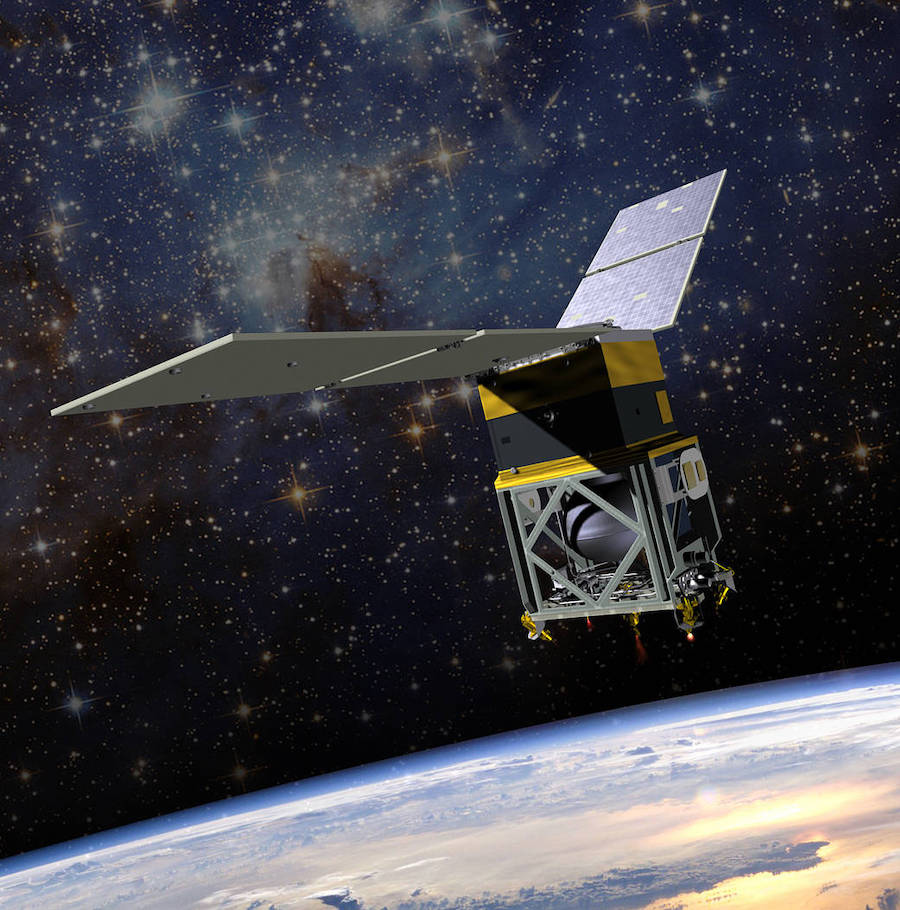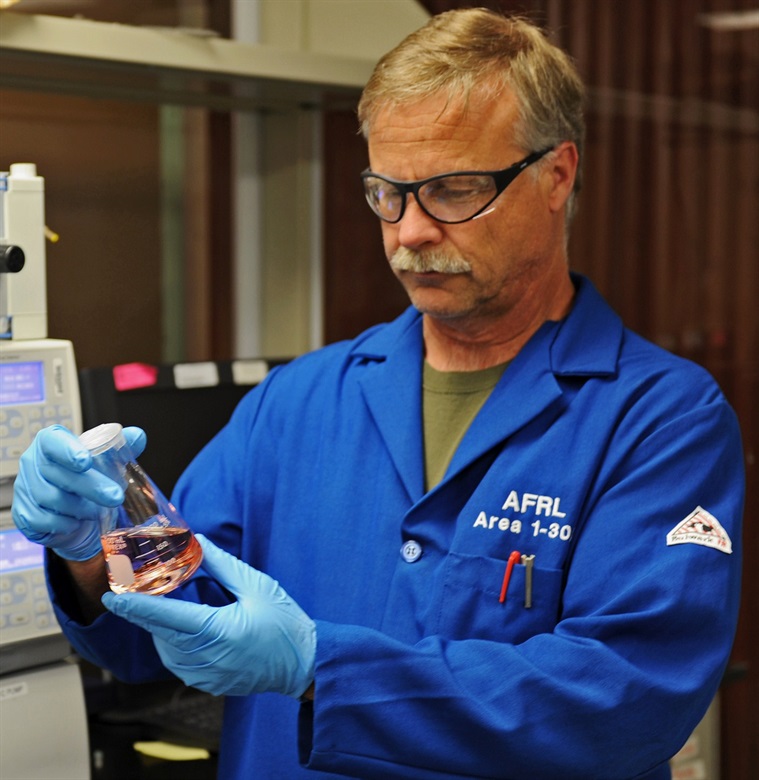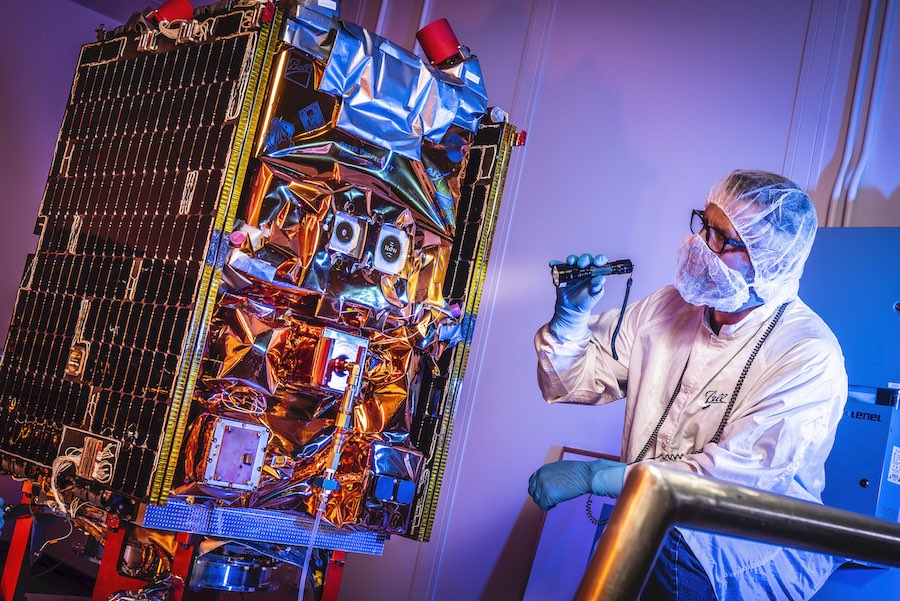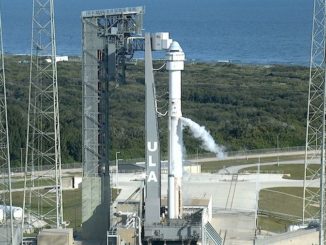
A NASA-funded satellite that launched last year on the third flight of SpaceX’s Falcon Heavy rocket has begun a sequence of thruster firings to begin falling out of orbit after successfully demonstrating the effectiveness of a non-toxic fuel that could fly on future space missions.
The Green Propellant Infusion Mission, or GPIM, spacecraft is in the final weeks of its in-orbit test campaign aimed at proving the usefulness of the non-toxic fuel that could replace hydrazine — a caustic liquid that requires special handling before launch — for spacecraft propulsion needs.
Ground teams exercised the GPIM spacecraft’s five thrusters across a range of operating modes over the past year, testing their ability to control the satellite’s attitude, or pointing, and demonstrating their effectiveness at changing the spacecraft’s orbital altitude.
“GPIM has accomplished what it was designed to do,” said Brian Marotta, the GPIM mission’s attitude determination control and control lead at Ball Aerospace and Technologies Corp., which built the spacecraft for NASA. “We flight qualified a brand new domestic propulsion technology on a very capable and flexible spacecraft platform.”
Clare Skelly, a NASA spokesperson, said Monday that the GPIM spacecraft has begun a final set of thruster burns to lower the perigee, or low point, of the satellite’s orbit to around 111 miles, or 180 kilometers.
Marotta said earlier this month that those maneuvers would be completed by the end of August. At such an altitude, the refrigerator-sized GPIM spacecraft will naturally succumb to aerodynamic drag, fall back into the atmosphere, and burn up on re-entry within a few weeks, Marotta said in a presentation at the 34th Annual Small Satellite Conference, which was held in a virtual format earlier this month due to the COVID-19 pandemic.
The main purpose of the $65 million GPIM mission was to test the performance of a hydroxyl ammonium nitrate fuel and oxidizer blend called AF-M315E, which could take the place of hydrazine used in conventional satellite propulsion systems. Hydrazine is often mixed with nitrogen tetroxide, another hazardous chemical, to feed small maneuvering thrusters on-board satellites in space.
The “green” propellant blend comes with several benefits, officials said before the mission’s launch.
Technicians can load the AF-M315E blend onto a spacecraft without needing to wear protective self-contained suits to guard themselves against a toxic leak. The green propellant blend is more dense and viscous than hydrazine, allowing more of the AF-M315E fuel to fit into the same tank volume.
That results in an improvement in the performance of a spacecraft’s propulsion system.
“If I compare this to a standard monopropellant hydrazine system, we have 50 percent more total impulse available, mainly due the density of the propellant,” said Chris McLean, the GPIM mission’s principal investigator from Ball Aerospace. “So for a given tank volume, we’re able to squeeze in 50 percent more propellant, which means 50 percent more mileage for the spacecraft.”

The non-toxic AF-M315E fuel is also not prone to freezing in space like hydrazine, which requires heaters to stay warm enough to remain a liquid.
Hydrazine is a hypergolic fuel, meaning it combusts when mixed with other chemicals, like nitrogen tetroxide. The AF-M315E fuel requires hotter temperatures to ignite, making it safer to handle, but subject to more extreme operating conditions once in space.
Air Force engineers invented the AF-M315E fuel blend in 1998 at Edwards Air Force Base in California. One of the reasons it took so long to test the AF-M315E fuel in space was the hot temperature required to ignite the propellant.
“This looks a lot like a standard hydrazine monopropellant technology, except the material demands are extreme,” McLean said before GPIM’s launch last year. “Over the course of this program, we got the point where we got to an engine that could handle these excessive amounts of enegy successfully, over and over again, and we proved that through extensive ground testing at Aerojet Rocketdyne.”
The next step was a demonstration in space.
According to Marotta, the GPIM satellite performed a series of experiments to gather data for engineers to evaluate the performance of the green propulsion system, which was supplied by Aerojet Rocketdyne.
“The primary objective is to flight quality the AF-M315E-based propulsion system through a series fo comprehensive on-orbit demonstrations and tests,” he said. “We performed characterization of the thruster efficiency over the life of the system across a range of tank pressures to better understand the thruster performance as the system matures, and as it ages on orbit.”
The 348-pound (158-kilogram) GPIM spacecraft was one of 24 satellites launched aboard SpaceX’s third Falcon Heavy rocket in June 2019. The rideshare mission was managed by the U.S. Air Force, and delivered payloads to orbit for NASA, the military, and universities.
GPIM separated in a circular orbit roughly 447 miles (720 kilometers) above Earth, with an inclination of 24 degrees to the equator.
After extending its solar arrays and passing a preliminary checkout, the spacecraft kicked off a series of demonstrations of its propulsion system. One of the first major maneuvers was to lower the perigee, or low point, of its orbit to about 338 miles (545 kilometers) to comply with guidelines ensuring the spacecraft will re-enter the atmosphere within 25 years.
Marotta said ground controllers commanded GPIM to hold its attitude, or orientation, using the satellite’s five control thrusters fueled by the green propellant blend. The spacecraft has four canted control thrusters positioned on its corners, plus a central thruster mounted on the spacecraft’s main body.
The thrusters were also used to regain control of the spacecraft after it was put into a tumble, and the propulsion system demonstrated it could control momentum built up by the satellite’s reaction wheels. The experiments showed the green propulsion system could be used on satellites orbiting Earth, or on deep space missions, Marotta said.
“We followed an incremental and measured approach to the propulsion system checkout, starting with simple tests and gradually increasing complexity,” Marotta said.
GPIM then incrementally lowered the perigee of its orbit again before commencing the final set of thruster burns targeting a perigee of 111 miles.
Marotta said the remaining burns will continue providing valuable data on how the green propulsion system performs as it ages. The final burns are expected to consume the last of the 31.3 pounds (14.2 kilograms) of AF-M315E propellant launched with the GPIM spacecraft.
In remarks Aug. 3, Marotta summed up the GPIM mission as “very successful.”
GPIM also hosts secondary experiments for the Air Force Academy and the Naval Research Laboratory to measure plasma densities and temperatures, and characterize neutral and ion particles in the upper atmosphere. The satellite also carries an experimental device from the Air Force Institute of Technology to estimate its position and velocity in space using GPS signals.

Bradford ECAPS, based in Sweden, has also pioneered green propellants for satellites. The ECAPS fuel, named LMP-103S, has flown in orbit on Sweden’s Prisma technology demonstration mission, Planet’s SkySat Earth-imaging satellites and the U.S. military’s STPSat 5 experimental satellite.
The Swedish-developed fuel has many of the same advantages as the AF-M315E propellant. The U.S. fuel is more dense — which offers some technical advantages — and will help U.S. industry enter the green propellant market.
“Having a U.S. supplier of certain technologies is important to some of our customers, and I focus my energy there,” McLean said last year.
In spacecraft design, green propulsion still faces tough competition from conventional hydrazine systems, electric thrusters, and newer water-based propellants.
“The green technology offers the big benefit of not being hazardous compared to hydrazine, and I think that could be a very attractive option, especially for smaller satellites that are done by smaller companies that might not have all the capabilities of handling hydrazine and dealing with that,” Marotta said Aug. 3. “I think we’re getting there. It could take some more time and might require a few more missions to get us over the hump.”
Email the author.
Follow Stephen Clark on Twitter: @StephenClark1.



